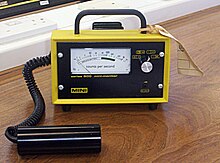Radioactive decay is the process by which an atomic nucleus undergoes a spontaneous change, emitting an alpha particle or beta particle and/or a gamma ray.
Radioactive decay is a natural process that takes place in the air, water, and soil at all times. The decay of isotopes such as uranium-238, radium-226, radon-222, potassium-40, and carbon-14 produce radiation that poses an unavoidable and, probably, minimal hazard to human health. Scientists have also learned how to convert stable isotopes to radioactive forms. The radioactive decay of these isotopes has been added to the natural background radiation from naturally radioactive materials.
Types of Radioactive Decay
Alpha Decay
An element in alpha decay loses two neutron and two protons. This moves the element back two places on the periodic table.—most common in elements with atomic number greater than 83-- It is not particularly strong, but the alpha particles can knowck atoms off of molecules
Beta Negative Decay
Increases proton by one and LOSS of one neutron. The smaller particles make it more penetrating than alpha but less penetrating than gamma decay. Penetrates through one cm of flesh before they are stopped.
Gamma Decay
Occurs when the parent isotope falls into a lower energy state. It is the most strong/penetrating. Gamma radiation emits photons that can pass through the body and causee damage by ionizing the molecules in their way.
Positron Emission [Beta Positive Decay]
A positon is like an electron, except it has a positive charge. This is a reaction when the radiation produces positrons
Electron Capture
The nucleus captures one of its atoms inner shell electrons, so the atomic number is reduced by one. This electron joins with a proton in the nucleus to form a neutron.
All elements with an atomic number over 83 are considered radioactive. Radioactivity can be measured using a geiger counter.
Different types of Radiation
ALPHA RADIATION
Heavy, short range, ejected helium nucleus. It can’t penetrate human skin. But if it is inhaled, swallowed, or absorbed through open wounds, it can be harmful.
Geiger-Mueller probe can detect the presence of alpha radiation. Travels a short distance.
radium, radon, uranium, thorium.
BETA RADIATION
Travels a few feet into the air, can penetrate a very thin layer of the skin If if beta radiation are in contact with the skin for a long time they can cause injury.
Difficult to detect, clothing provides a little protection to the skin
strontium-90, carbon-14, tritium, and sulfur-35. difficult-to-detect beta emitters are hydrogen-3 (tritium), carbon-14, and sulfur-35.
GAMMA & X RAYS
Gamma Travel many feet in the air and deep into human tissue. They are known as “penetrating” radiation
X rays – similar to gamma,
Electromagnetic radiation=UV rays, radiowaves, visible light according to energy levels
During radioactive decay, gamma radiation or x rays frequently accompany the mission of alpha amnd beta radiation.
Gamma Emitters: iodine-131, cesium-137, cobalt-60, radium-226, and technetium-99m.


No comments:
Post a Comment